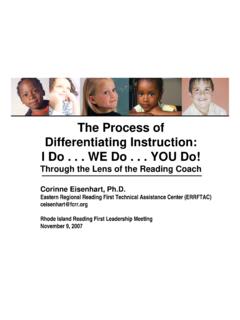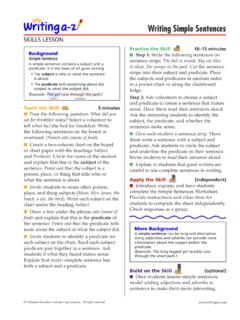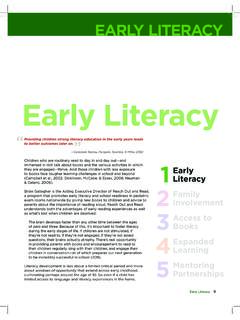Transcription of On Target: Strategies to Build Student Vocabularies
1 On Target: Strategies to BuildStudent VocabulariesESA Regions6 & 7 Grades 4 - 122 Dear Educator:It seems obvious to say that a strong vocabulary contributes to reading comprehension. Yet, frequently as educators particularly at the middle school and high school levels we neglect toteach vocabulary in a manner that is explicit and direct for our students . Frequently, we providestudents with the vocabulary they need but fail to teach them how to access that vocabulary and makethe words their do students own words? They own the words when they can use words in a variety of students are able to and choose to incorporate new vocabulary into their writing and speak-ing, then as educators, we can infer that students truly understand the vocabulary and, in fact, own then, we need to focus on ways to help our students own the words we believe they need fromeach of our content areas.
2 Research suggests educators focus on four practices that help bring wordsalive for their students (Blachowicz and Fisher, 2004): Develop word awareness and love of words through word of the Strategies and activities in this booklet focus on this aspect of vocabularydevelopment. Too often, in an attempt to cover as much content as possible, we forget to giveour students the opportunity to play with words. We forget that while they play with words, students create meaning. Develop explicit, rich instruction to Build and Fisher suggest the STAR model because it provides explicit vocabularyinstruction. This model is featured on page 5 of this booklet. Build Strategies for students learn to understand vocabulary by using context clues, word parts, and,yes, even dictionaries can lead to word ownership.
3 However, teachers need to explicitly teachstudents how to use these tools to develop the skills needed to make use of context clues,word parts, and dictionaries. Engage students actively with a wide range of students to many forms of literature in a variety of ways including reading aloud toand with them helps students develop broad Target: Strategies to Build Student Vocabularies focuses on these four practices, particularly thefirst three which are relevant in all content areas. The Strategies featured here are ones that teacherssay work well in their classrooms. They are Strategies that are supported by research and best practicein Preszler, Education SpecialistSD Education Service Agency, Black Hills Region 7 Source:Blachowicz, Camille L.
4 Z., and Peter Fisher. Vocabulary Lessons. Educational Leadership(March 2004): CreditsJune Preszler, Barb Rowenhorst, & Jo Hartmann, editors; Gloria Gunn, designer;Nancy Hall, Dean of Education, Black Hills State University, content On Target strategy booklets are created by ESA 6 & 7 with support from the SD Dept. of Education Copyright 2006: Black Hills Special Services Cooperative (BHSSC)1925 Plaza Boulevard, Rapid City, SD 57702 BHSSC grants teachers permission to photocopy material for personal classroom of ContentsVocabulary 4 Developing Effective Practices .. 5 STAR .. 6 Discussion Starter 8 Semantic Feature 10 Ask a Question? 12 Talk Fast Talk a Mile a 14 Draw It 16 After Reading Card 17 Name that Category The Pyramid 18 Crossword 20 Synectic 21 Word 22 Vocabulary 24 Magic 26 Connections to Previous On Target 28 Websites to 29 For Further 30 Introduction to On Target: Strategies to Build Student VocabulariesResearch in educational psychology has led to substantial improvements in our knowledgeabout teaching and learning.
5 Researchers have identified Strategies that can be taught byteachers and used by students to significantly improve the quality of Student Target: Strategies to Build Student Vocabularies does an exceptional job of synthesizing theresearch regarding the vocabulary development of adolescents. Experts in the field believe thatvocabulary learning should not be left to chance. Vocabulary-building techniques benefit alllearners, but have been shown to be critical for learners with limited personal Strategies in this booklet get right to the point in applying research to practice. Based uponresearch and best practice for middle school and high school teachers, they present a practicalchart which outlines the teacher behaviors to increase and the teacher behaviors to do you find resources which guide you in what to stop doing in addition to giving younew who receive good strategy training in vocabulary development can apply these strategiesin a wide variety of life-long situations including job-related training, acquiring knowledge associ-ated with their interests and hobbies, and in preparing for post-secondary education.
6 Thisresource makes a valuable contribution to a needed, but frequently neglected HallDean of the College of EducationBlack Hills State University4 Vocabulary EssentialsBarb Rowenhorst, SD ReadsVocabulary knowledge is the single most important factor contributing to reading comprehension. Laflamme, 1997 Vocabulary instruction was identified in 2000 by the National Reading Panel (NRP) as anessential skill students need to improve reading achievement. The NRP identified fourtypes of vocabulary listening vocabulary, speaking vocabulary, reading vocabulary, andwriting vocabulary. Vocabulary, or word meaning, is one of the keys to comprehension. Astudent reading a list of unconnected words on a page is similar to a struggling Student trying toread a narrative text without a general understanding of the words being read.
7 No meaning. No way students develop vocabulary is indirectly through reading, listening, and Student s background knowledge and prior experiences play a large role in vocabularydevelopment. As students Build connections between known words and unknown words, theydevelop a deeper understanding of their reading. Thus, the more experiences children havewith reading or being read to before they enter school, the more background knowledge theyhave to support the understanding of their develop vocabulary when teachers provide direct instruction on the use of effectiveword-building Strategies . Unfortunately, Durkin (1979) found that upper-elementary teachersspent less than 1% of classroom instruction on vocabulary development.
8 Later research studiessupport those earlier findings with only 6% of time devoted to vocabulary (Scott and Nagy,1997). Marzano lists eight research-based guidelines for teachers implementing directvocabulary instruction in his books Building Background Knowledge and Building AcademicVocabulary: Teachers vocabulary instruction does not rely on definitions alone. Words should be written in aconversational manner rather than in the more formal dictionary format. If prior exposures to orexperiences with a word are lacking, teachers can Build the background knowledge through fieldtrips, videos, guest speakers, stories, or current must represent their knowledge of words in linguistic and/or nonlinguistic ways.
9 Studentscan draw a picture, create a symbol, or dramatize the vocabulary instruction involves the gradual shaping of word meanings through multipleexposures. These include comparing and contrasting, classifying, and creating metaphors word parts (prefixes, root words, suffixes) enhances Student understanding of the types of words require different types of should discuss the terms they are learning through cooperative learning should play with words using challenging and engaging vocabulary Essentials (cont.) should focus on terms that have a high probability of enhancing academic 1 words are concrete and easy to identify with little or no instruction. Level 2 wordsappear in text so infrequently that the possibility of learning them in context is slim.
10 Level 3words are specific to a particular content area. Marzano recommends teaching words inLevel 3 (content-related words) rather than those that are seldom encountered during must use a word between six and fourteen times before they are capable of using itindependently (Billmeyer, 2001), so they need multiple opportunities to interact with direct vocabulary instruction does not have to be boring. That is why this booklet providesseveral opportunities for teachers to engage students in developing vocabulary knowledge in fun andinteractive ways. Once students understand how words work and Build a cache of known words, theydevelop a desire to learn more words and fluency and comprehension improves.


